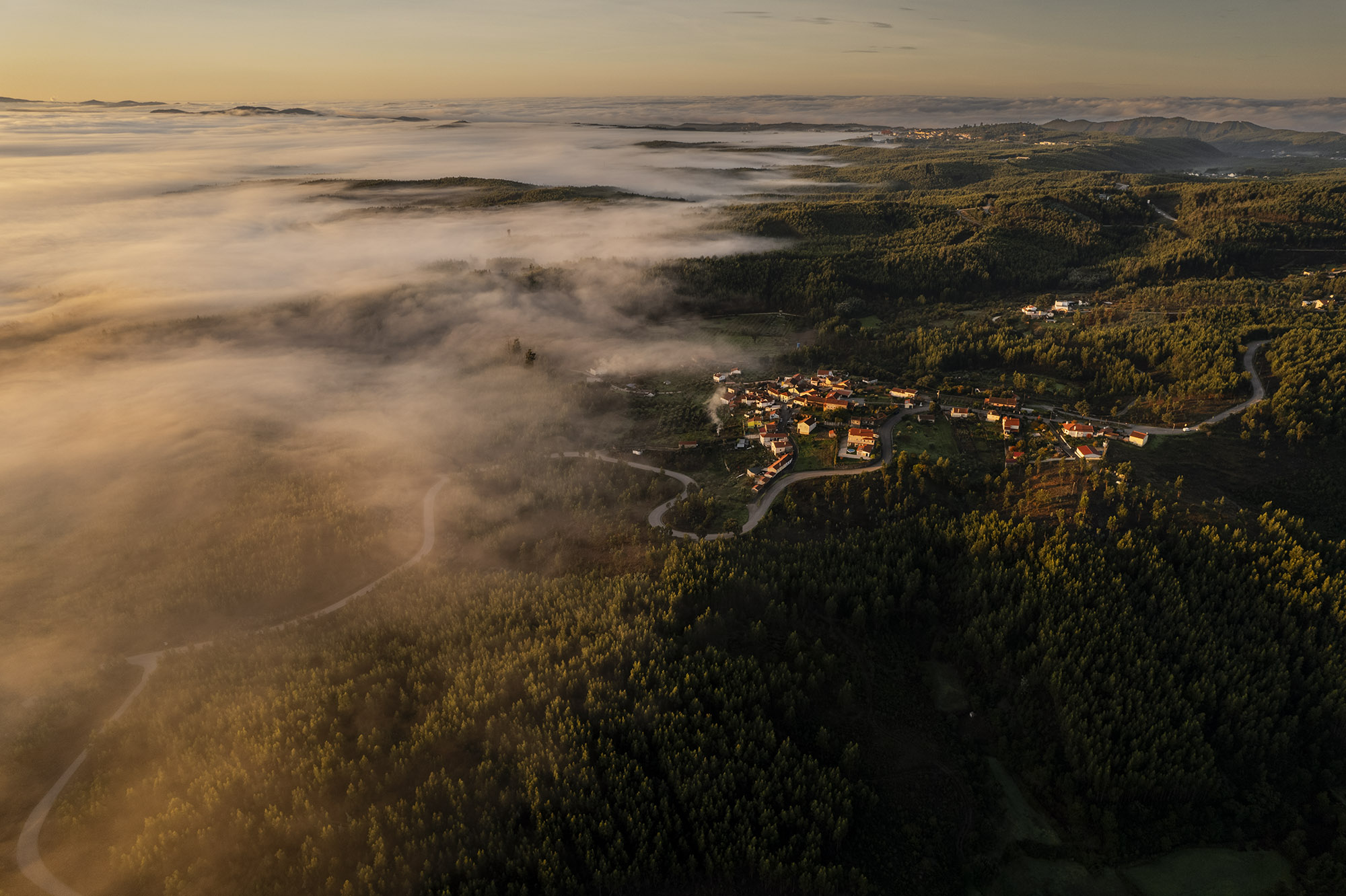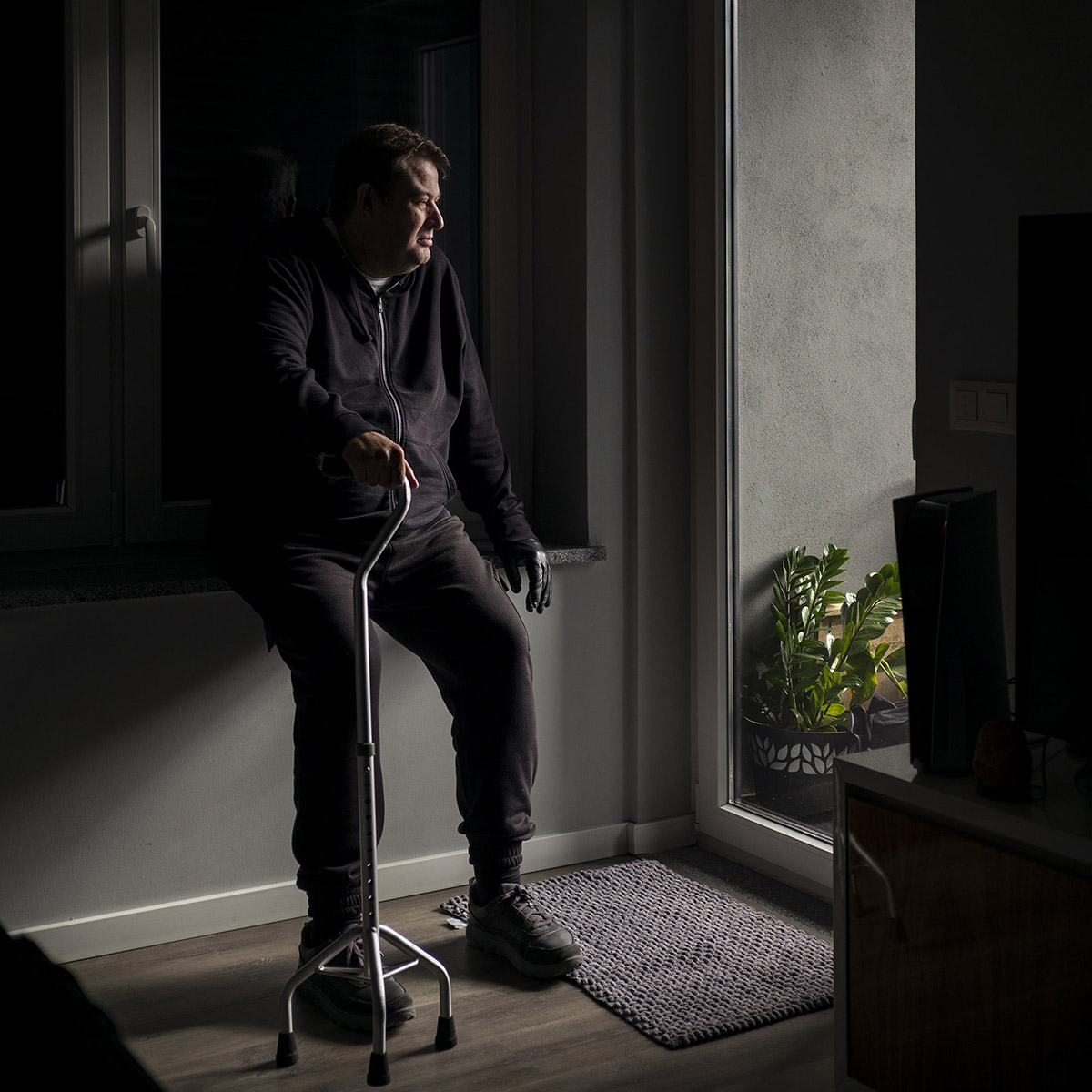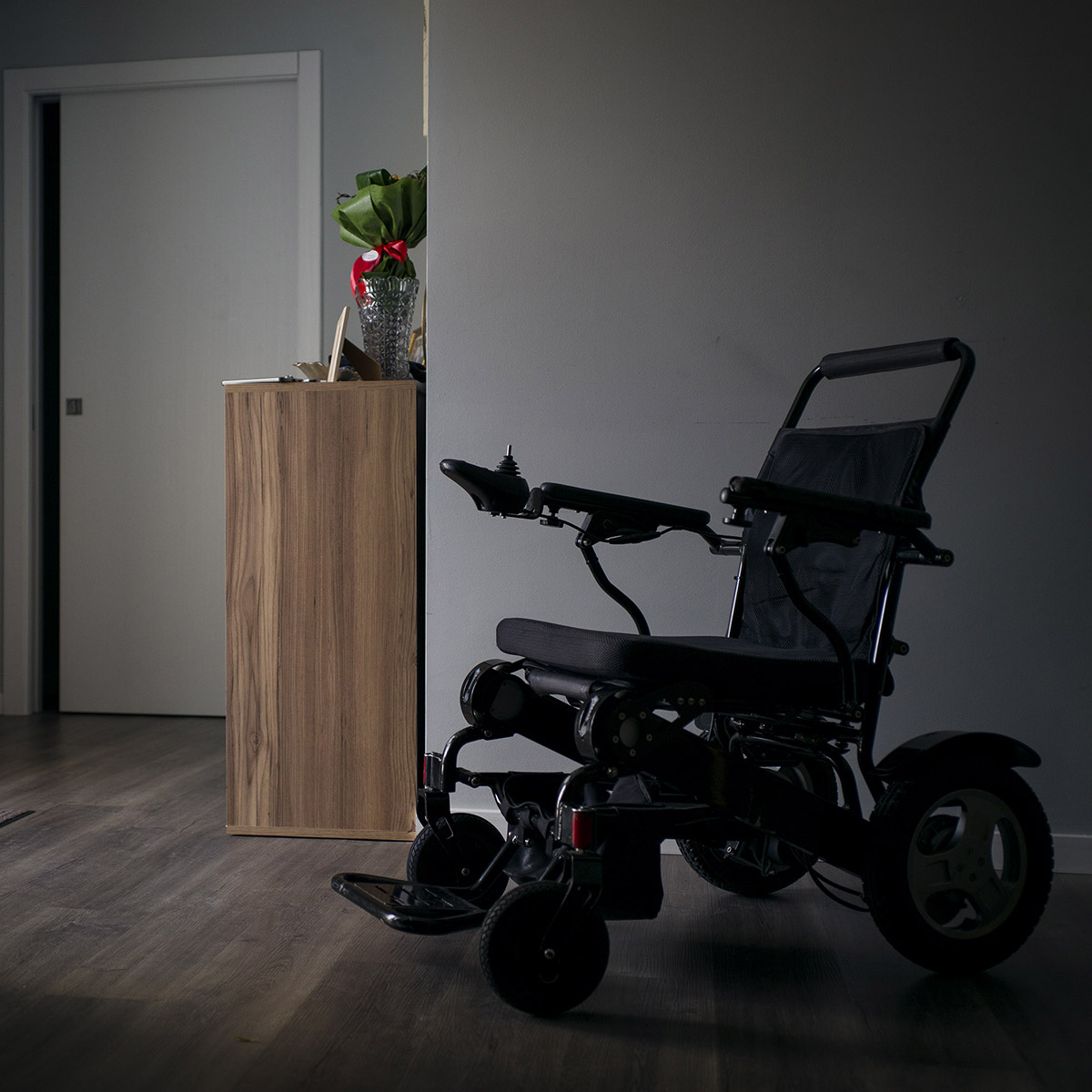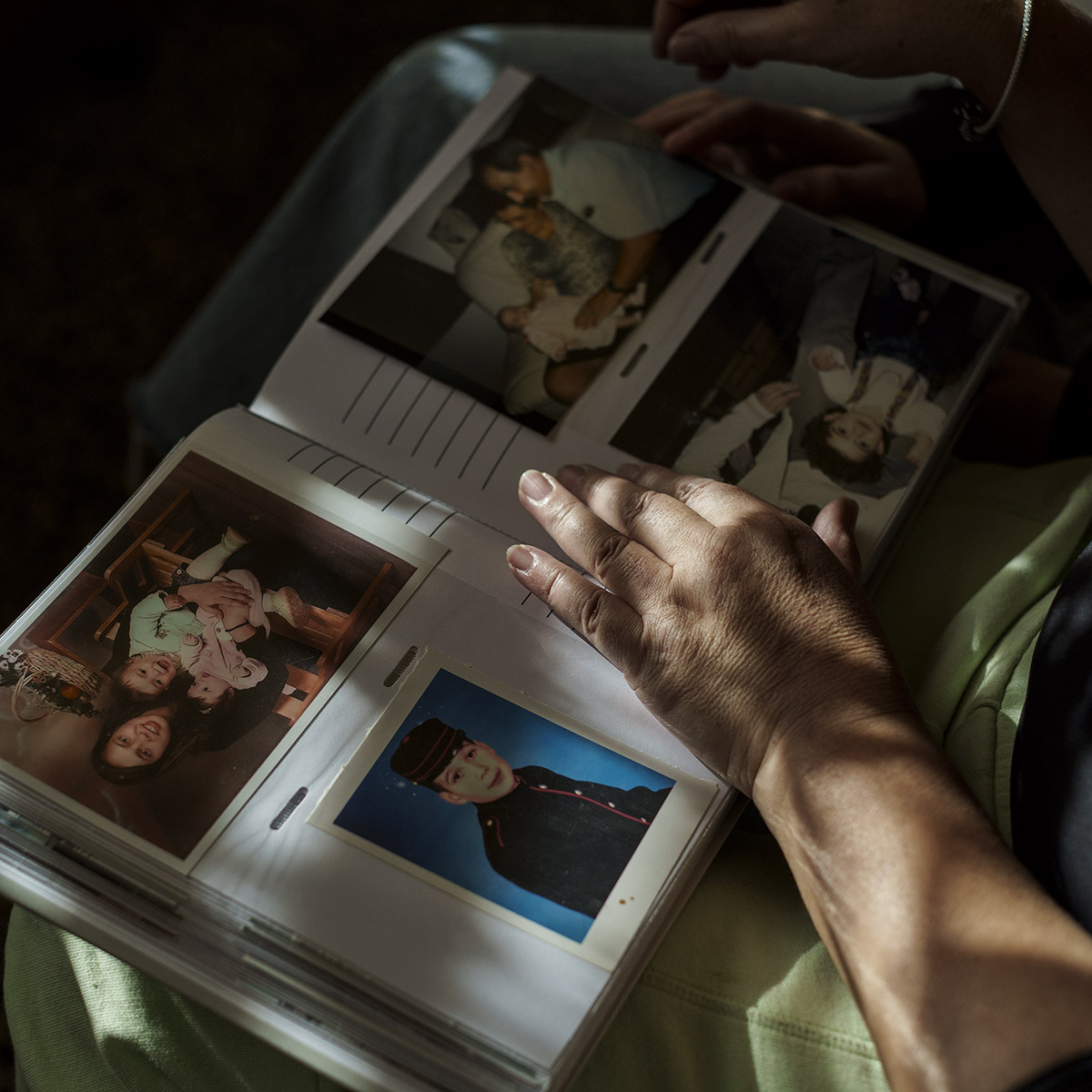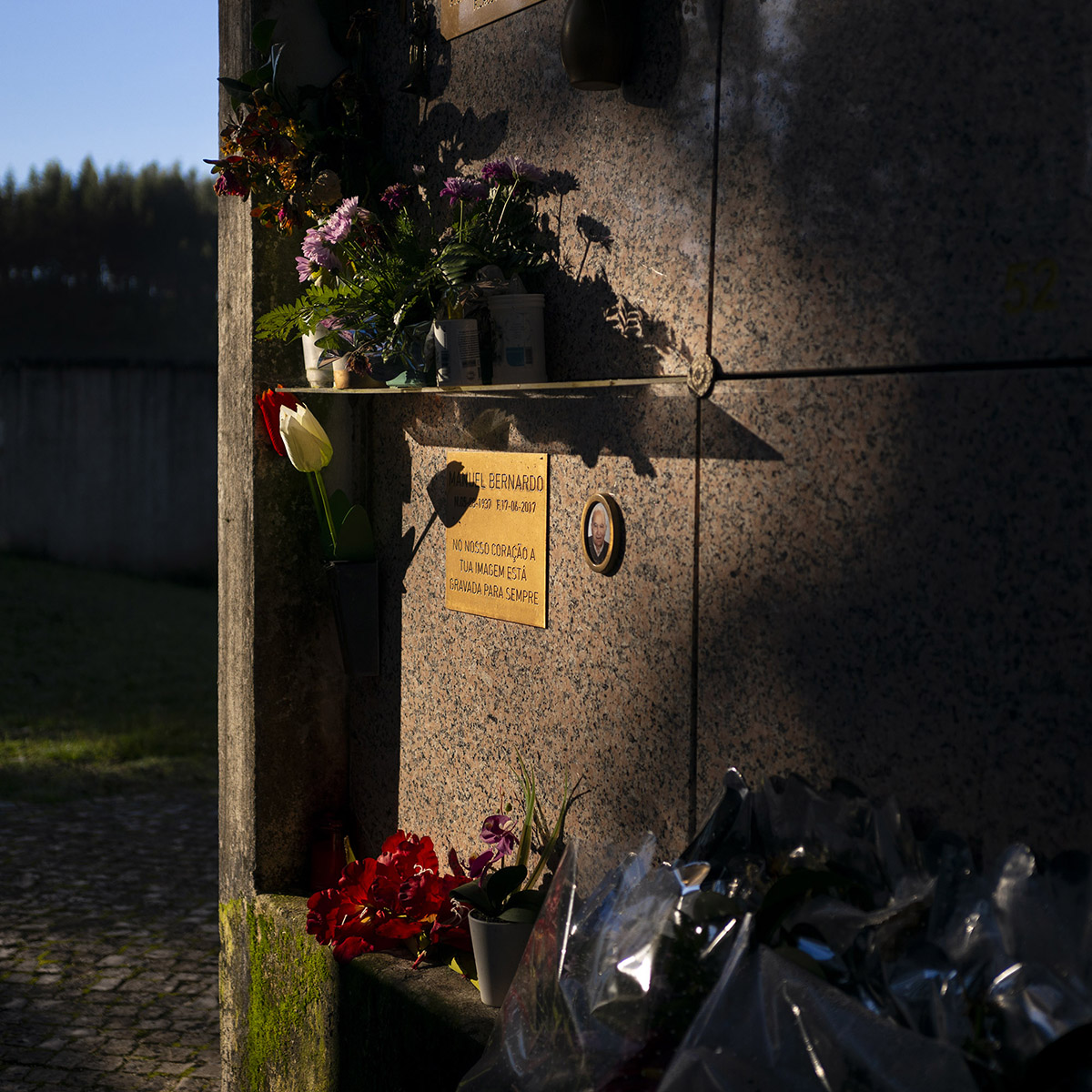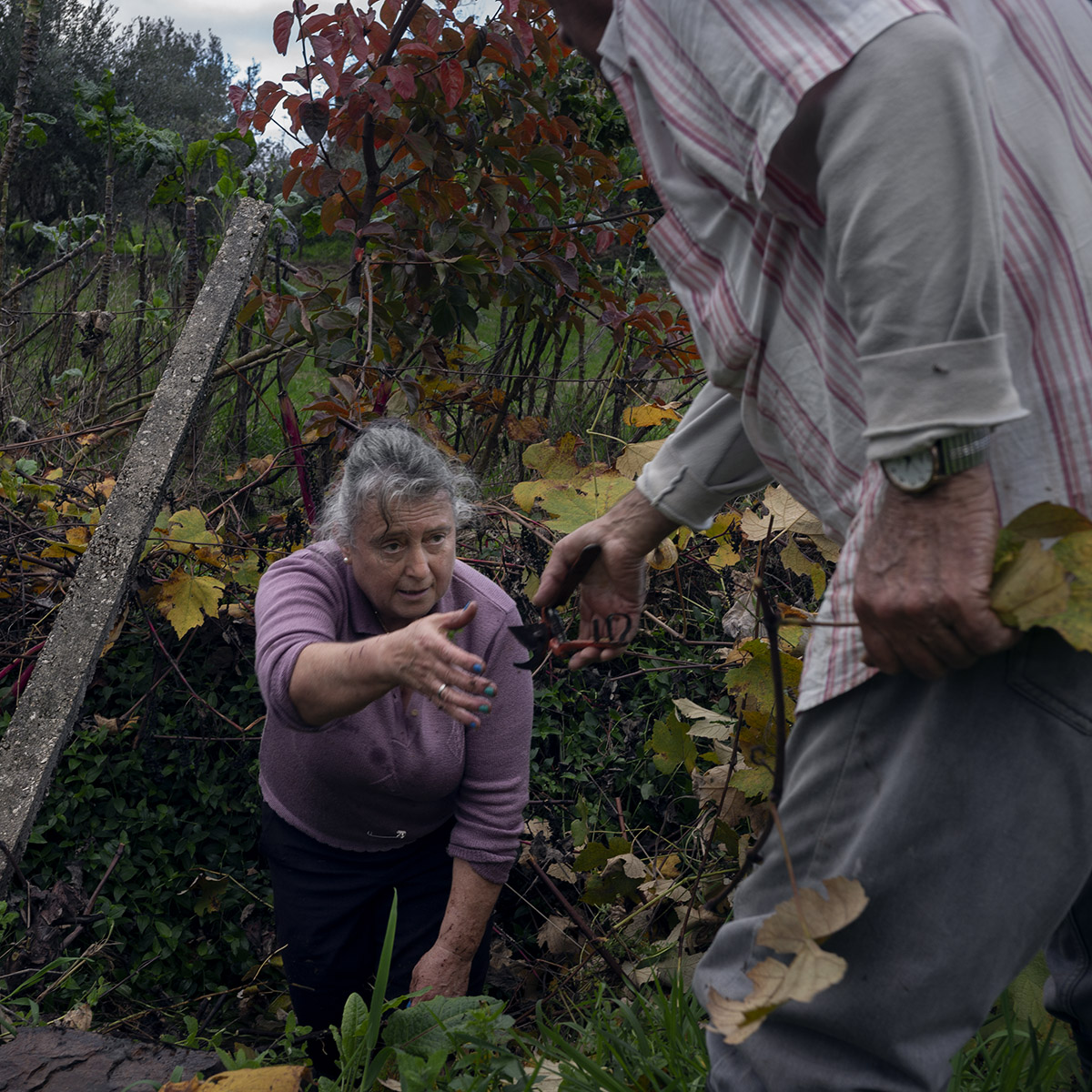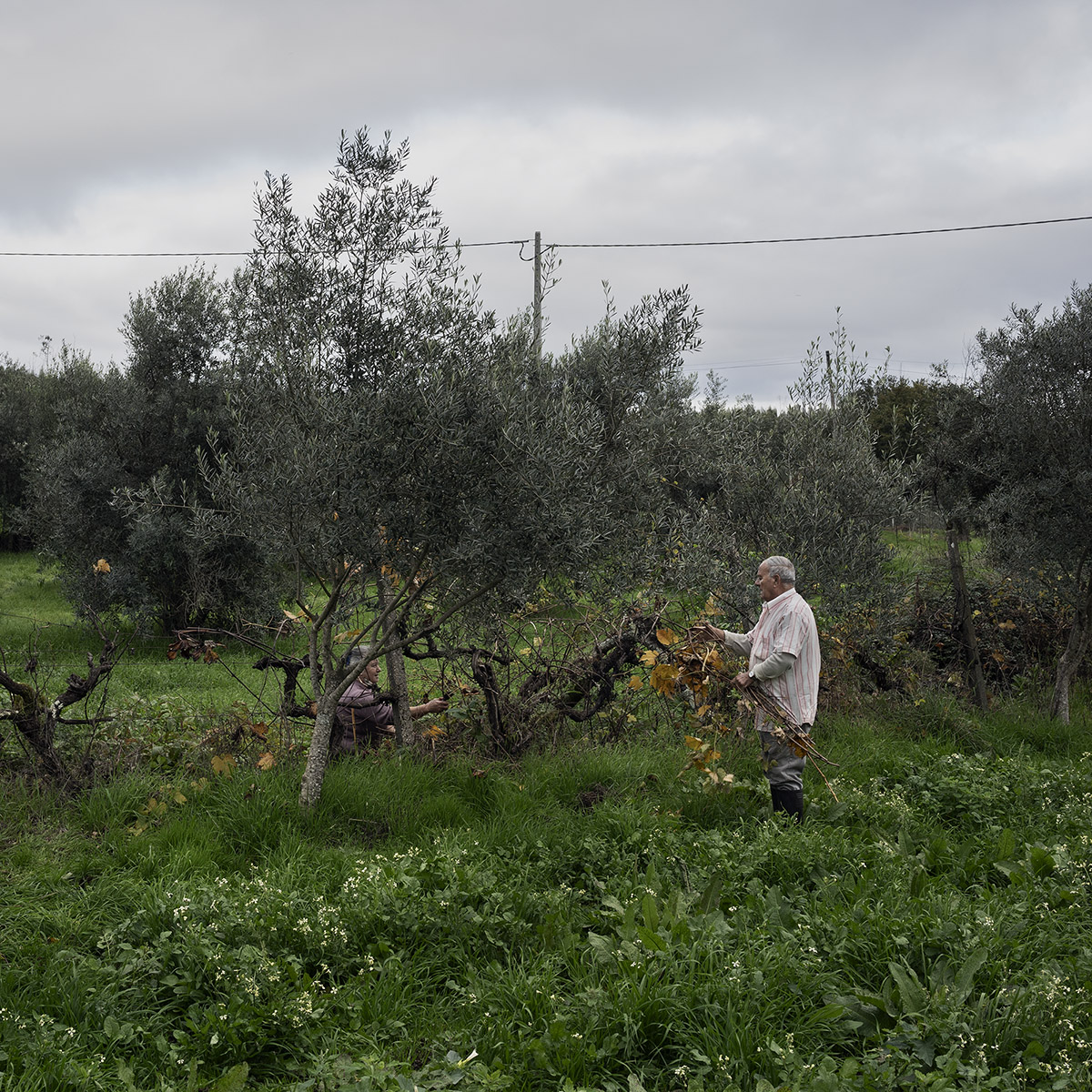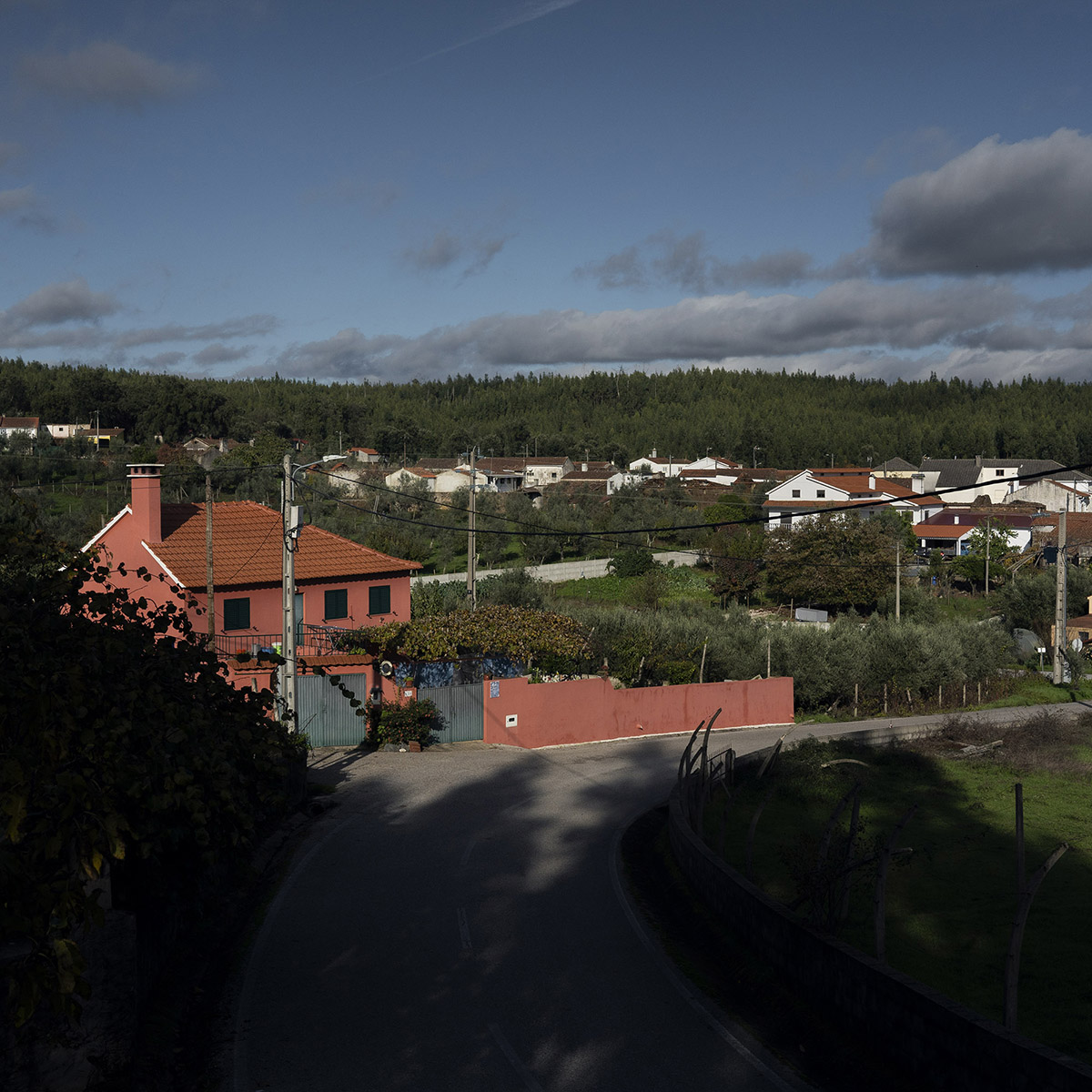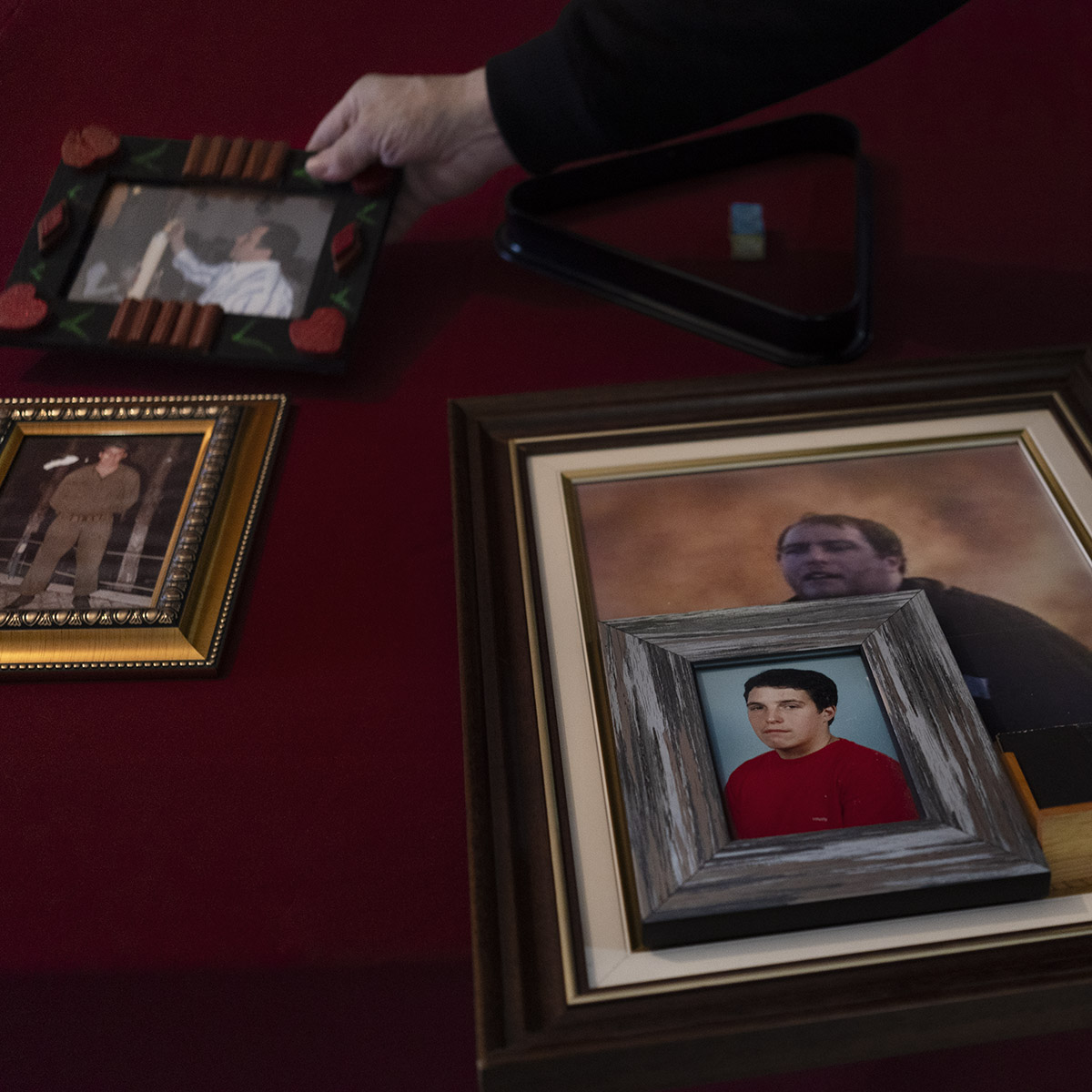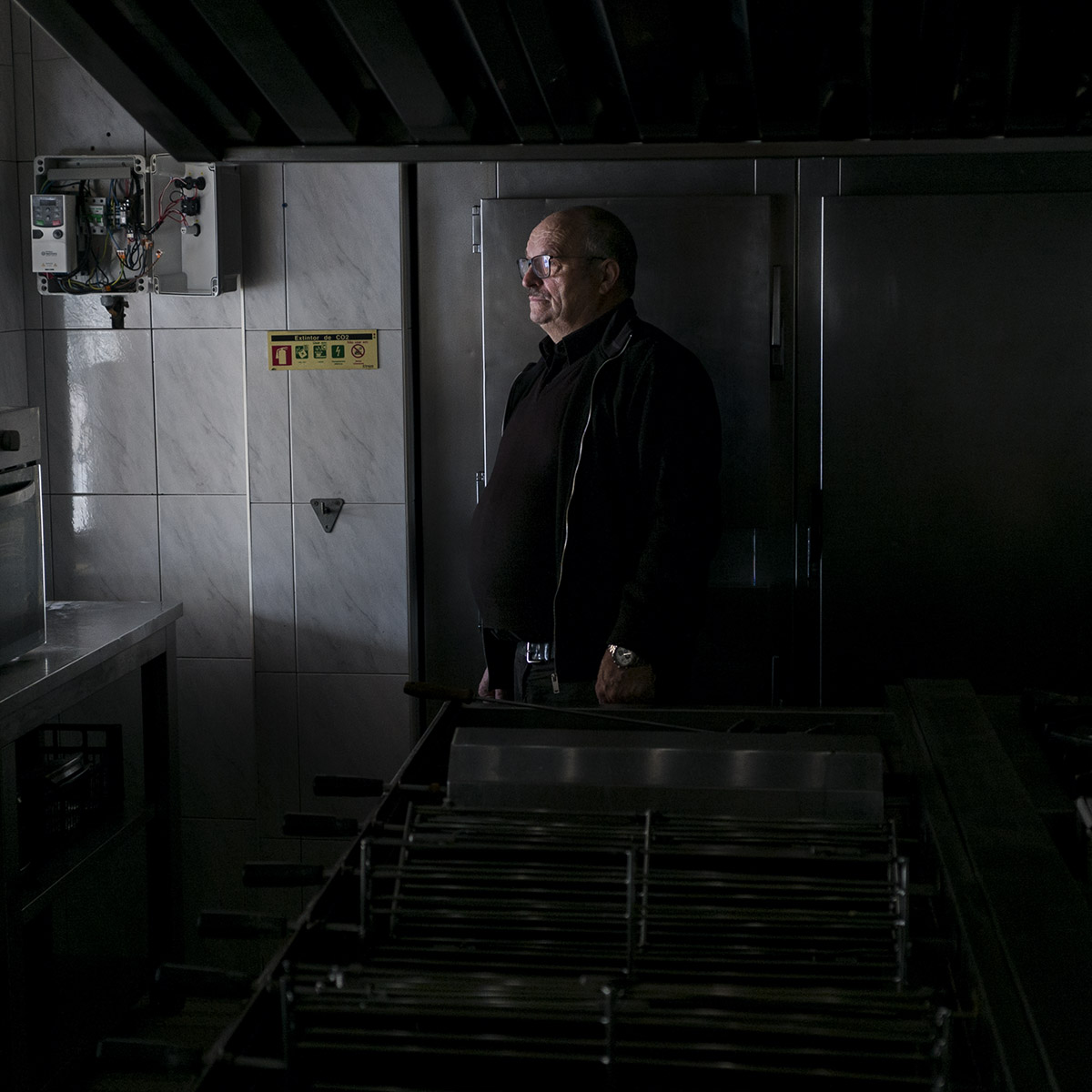This report was developed with the support of Journalismfund Europe.
The Open Wounds of Pedrógão Grande
Six years after one of Europe's deadliest mega fires
Maria da Conceição, 63, grips a portrait of her son, Gonçalo Fernando Correia Conceição, the only firefighter to die during Portugal’s Pedrógão Grande mega fire of 2017. Gonçalo was severely injured after he and his team became trapped in the flames during the extinction operation. Six years after the fire, Maria remains grief stricken by the loss of her son who was well-loved by the Castanheira de Pêra community. © Paulo Nunes dos Santos for Sonda Internacional
Project summary
#IIFFsondaMega Fires: Beyond Extinction
This project seeks to illustrate the circumstances surrounding the mega fires devastating Spain by generating a central guide to this phenomenon, presenting the new fire behavior and explaining its consequences on the land and the people. It will also compile the strategies for combating and living alongside them; unearth how ecosystems recover and utilize them; and share the solution projects mitigating their proliferation. As always, the project will tell these stories through photo, video and graphic resources as the main tool. Because seeing is essential to understanding.
Conversations #01: What is a mega fire?
Spanish Lapland
Fuelling a Mega Fire
Facing Fire
‘Lumes’ by Adra Pallón
Join our crowdfunding!
Take the opportunity to directly support in-depth journalism on the climate crisis
Donate
20 December 2023
* Editors‘ note: we recommend viewing the report on a large screen (computer) to enjoy a more immersive experience. For better navigation, images appear resized on mobile devices.
The fire storm’s intensity melted skin off hands and feet, liquified glass windows and reduced standing signs to puddles of metal. The ferocious wind whipped heat up from the burning forests, thrusting flames forward before crashing them down on the small towns dotted across Portugal’s central region, suffocating the area in thick black smoke.
On the afternoon of Saturday 17 June 2017, a complex of at least five wildfires ignited, spread and merged across 11 small towns surrounding the municipality of Pedrógão Grande in Central Portugal creating an unstoppable and catastrophic fire event. Sixty-four people died and 250 were injured. Over five days more than 46,000 hectares of land were destroyed. The fire struck territory carpeted by highly flammable, abandoned pine and eucalyptus plantations at a time of prolonged drought and enduring heat waves. The major triggers were found to be contact between vegetation and a 25 kV electrical line as well as lightning strikes.
Volunteer firefighter Rui Rosinha, 46, was called in as reinforcement. He was driving to one of the emerging spot fires when his team’s truck collided with a car on the N-236 highway near Pobrais, southeast of Coimbra. The crash stranded them on the side of the road and trapped the three unconscious passengers of the car. As the firefighters struggled unsuccessfully to free the passengers from the wreckage, the wind, radiation and heat from the approaching fire became unbearable. They were forced to save themselves and leave the passengers behind. Huddled together on a small island junction of raised concrete in the middle of the highway, Rui and his four colleagues then endured an hour of exposure to flames, heat, cyclonic winds and the thrashing of airborne debris. “We experienced temperatures that seemed impossible. The radiation came in waves. I felt it as if it were extreme waves of heat, I remember not just once, but many times the impact and pain, as it hit my body.” Though severely burnt the group were able to successfully shelter three adults and a child on the same junction. When help finally arrived Rui and the others were driven to medical centers before being airlifted to hospital and that’s the last thing he remembers.
“If ever there was a hell on earth, for me it was there.”
The fire moved at unbelievable ferocity, with more than 4400 ha burnt in a single hour, violently accelerated by intense wind gusts, emitting enough energy to propel itself and exceed the capacity of extinction within four hours of igniting. The severe speed of the fire, which by nightfall was advancing at 15 km/hr, outpaced evacuation orders and knocked out communication networks, trapping hundreds and killing dozens in their cars as they fled on the N-236 highway.
It was the worst mega fire in Portugal’s history. As a result of the disaster, family members of those who died and others who were seriously injured were compensated from a 2.5 million euro support fund. A complete reform of land management legislation was also prompted including the introduction of a new 10-meter clearing rule between roads and vegetation, the banning of new eucalyptus plantings and a shift away from purely reactive firefighting to prevention investment. The reach of the Pedrógão Grande mega fire has left physical, psychological and generational scars, altering the social fabric of the small communities forever.
How have the lives of those touched by Portugal’s worst mega fire changed since the smoke cleared?
A fragment of aluminum from a vehicle melted in the Pedrógão Grande mega fire of 2017. © Mikel Konate for Sonda Internacional
RUI
Almost three months after the fire, Rui awoke from a coma to a new reality. He had suffered debilitating burns to his hands, back and feet, respiratory problems as well as partial paralysis to his left side due to injuries in a nerve plexus making him wheelchair dependent. “Those first nights, when I began to realize what had happened and when I began to understand my body and what was happening to me, those first nights were horrible.” He pleaded for psychological help as he grappled with suicidal thoughts, “I saw that I didn't have the capacity to deal with it [alone].”
Thrusted into this new reality beside him was his family. His distraught but resilient wife, Marina, 45, had anguished through the months he was in a coma with daily drives to the hospital two hours away and when he woke she became his full-time carer. His two young sons, Antonio and Francisco, 12 and 9 at the time, were confronted by a jarring role reversal in prematurely being the able men and joint caregivers of the house. Among these harrowing realizations for Rui was that his close childhood friend and colleague with him in the fire, Gonçalo Conceição, hadn’t survived. Rui says the guilt of surviving when his friend didn’t and not being able to save the passengers of the car, are two of the most complex psychological hurdles he is working on overcoming.
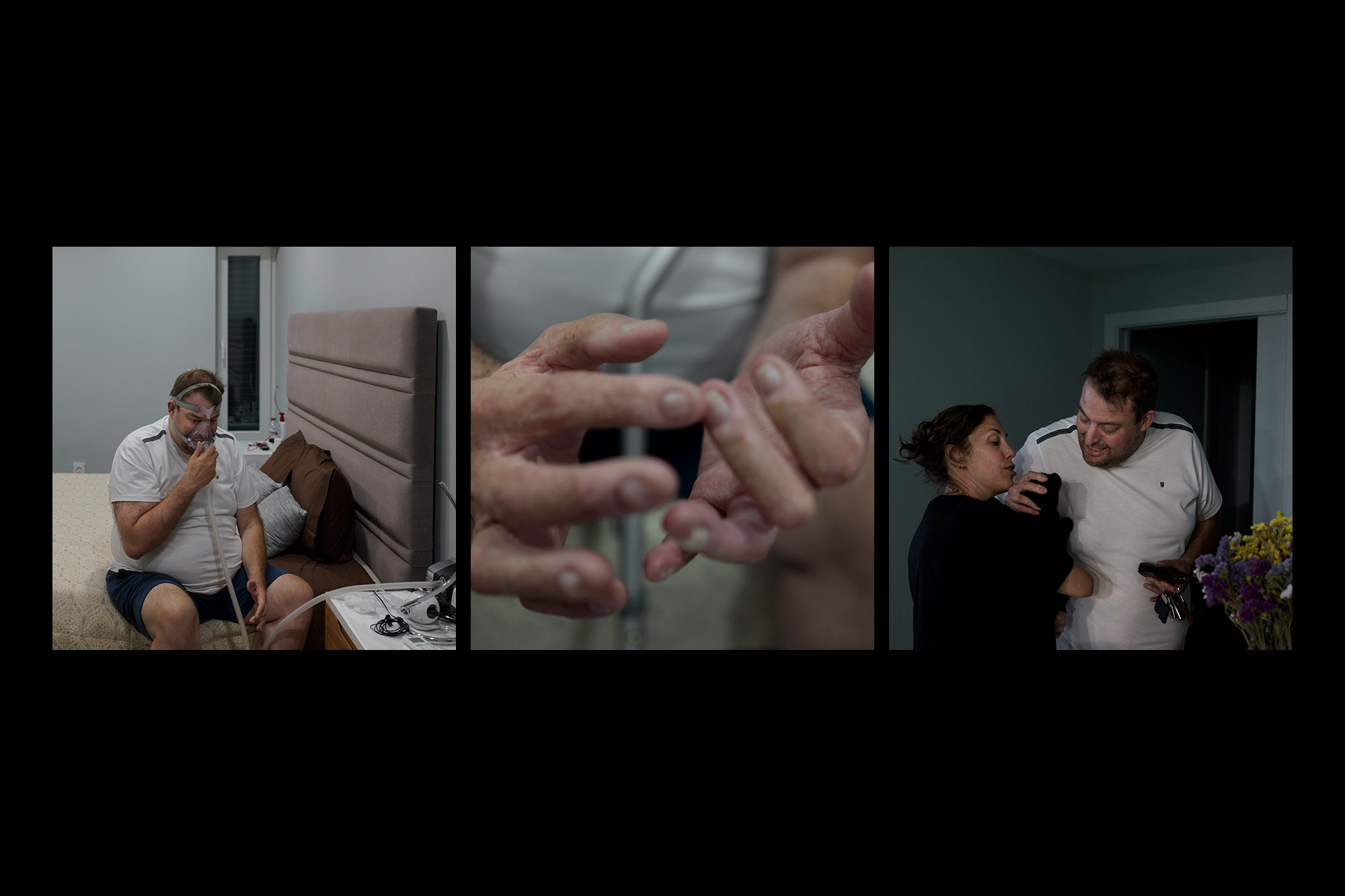
Former volunteer firefighter, Rui Rosinha, and his family live with the consequences of the Pedrógão Grande mega fire. Rui is still working through the trauma caused by the physical and psychological scars. © Paulo Nunes dos Santos for Sonda Internacional
“I’m managing to approach, and exorcize some ghosts and it is an almost permanent mourning to face traumas and talk about certain subjects that were taboo for me or at least I couldn’t face it.” Over the last six years, he has been able to reconcile and overcome parts of the trauma in a process that he says will never end, just forever evolve. “These are the steps I am taking, that I am achieving to feel more at peace with myself and be at peace with others too.”
Rui comes from a family of firefighters. With reduced mobility however he has been transferred away from active duties after 28 years of service and now the Castanheira de Pêra fire brigade, once a second home to his family, is a place he feels uncomfortable and alien within. Despite everything his family has been through, both his sons dream of pursuing the family tradition. For now, it’s a dream Rui and his wife are conflicted in supporting.
Ana Luisa Bernardo looks through a family photo album with her daughter. © Mikel Konate for Sonda Internacional
ANA
Some see daily reminders of the fire written on their bodies, while others face stubborn mental barriers in evolving past June 17. Ana Luisa Bernardo, 51, lost both her mother and father, Maria, 71, and Manuel, 80 in the fire. Their car crashed on the shoulder of a road as they fled the town of Sarzedas de São Pedro. “The descriptions from people were that the sky suddenly turned dark and they couldn't see anything. So, I believe he didn't realize that the turn was right there on a steep slope,” said Ana. Having worked as a diagnostic and therapeutic technician in hospitals for 25 years, she says not being able to save her parents brings immense pain, “Every day I still think about the subject. I can't dissociate.”
For two years Ana was so paralyzed by the pain of losing her parents, she was unable to enter their family home. She would visit it every weekend and clean the lower patio but not cross the threshold. Even now, Ana is still gradually sorting her parent’s belongings, a journey her daughter Sátia, 16, is helping her through, “What I'm trying to do is triage only what brings back good memories, what's bad is not worth keeping. It's very delicate.”
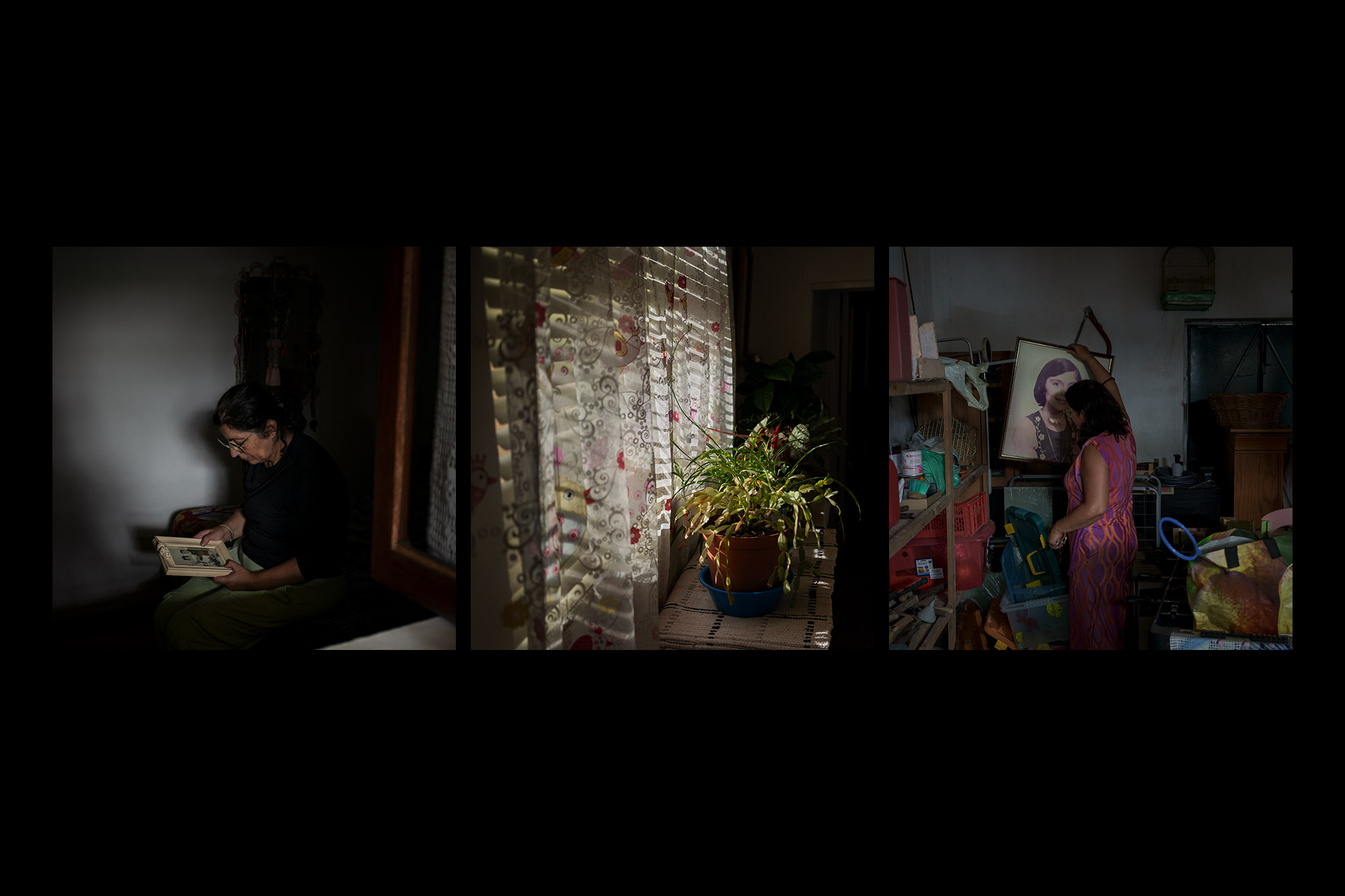
After years of debilitating grief, Ana Luisa Bernardo, has begun to sort through the belongings of her parents who died in the Pedrógão Grande mega fire. © Paulo Nunes dos Santos for Sonda Internacional
From what was already a network of small towns where most people are known to one another, now exists a new subcommunity forged by their shared grief and loss after the fire. This web of survivors refer to each other as a family who speak the same language of experience. “We share the same pain, some in one way, others in another,” Ana said of one of the tragic event’s rare silver linings.
But from the community the fire created, it also took away. Many of the towns affected haven’t been able to return to the bustling places they once were. Ana says in Sarzedas de São Pedro, the change is palpable.
Deolinda Henriques Simões and Antonio Dias Gonçalves cut weeds and bushes on their property, in an effort to reduce the risk of a new fire. ©Mikel Konate for Sonda Internacional
DEOLINDA & ANTONIO
Retired couple Deolinda Henriques Simões, 55, and Antonio Dias Gonçalves, 80, spend their weekends in the tiny town of Nodeirnho. The day before the fire struck, the renovations of their weekend home were finished. They escaped just in time but “in the blink of an eye” their new home was destroyed before they could enjoy it.
Once it was safe to return to the smoldering town, they drove back and found the remains of their home and all of their life savings destroyed beyond repair. “All the windows and doors were wooden in the old-fashioned way. I remember getting there, I only saw the walls and that’s what happened. So much so that the beams that I had placed in aluminum were all crammed together like snails,” said Deolinda.
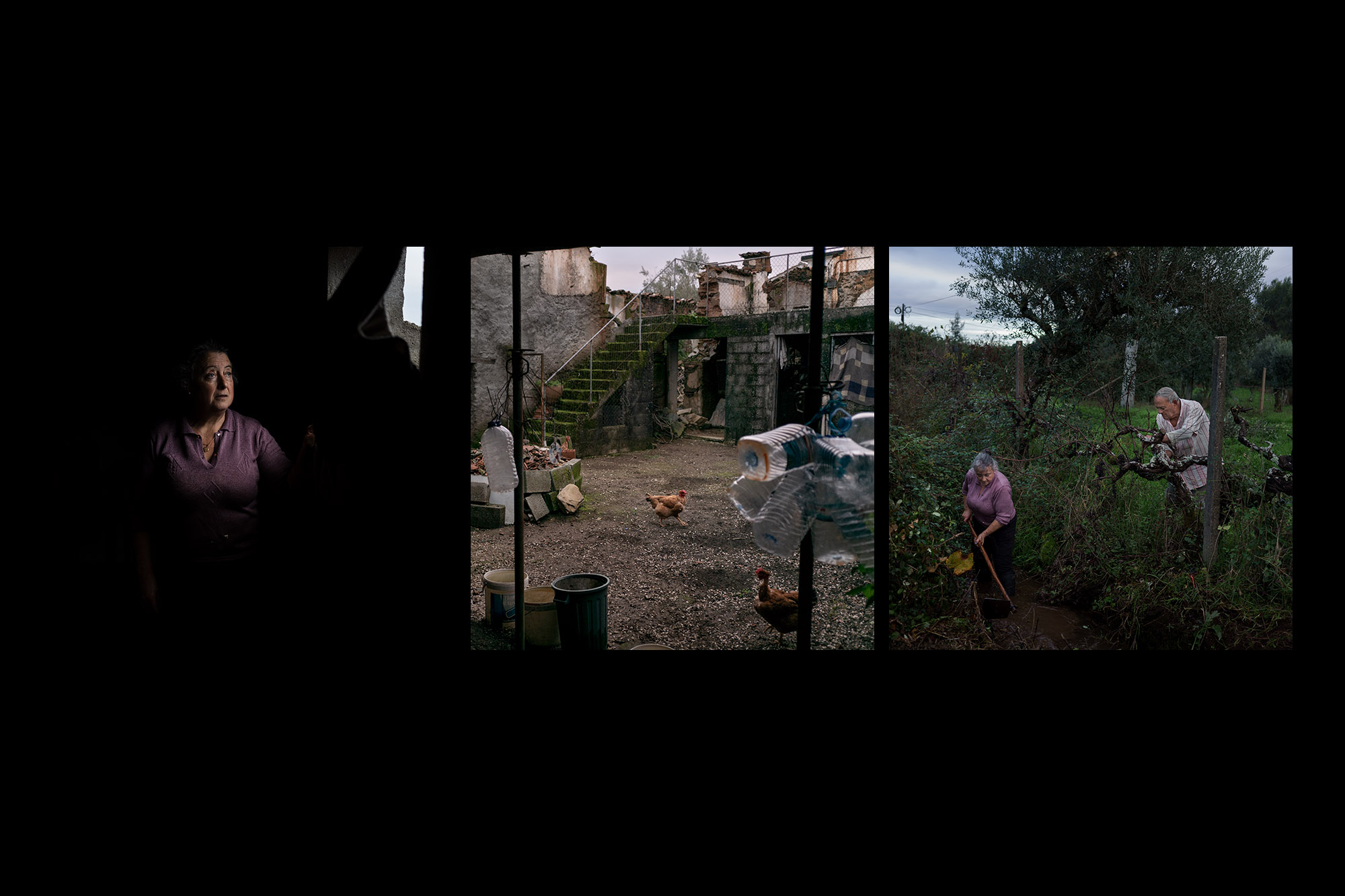
Deolinda Henriques Simões, gazes out of a window of her Nodeirinho home which was destroyed beyond repair during the mega fire of 2017. She and her husband, Antonio Dias Gonçalves, manage the land on their property to reduce the chances of another fire. © Paulo Nunes dos Santos for Sonda Internacional
It is estimated more than 1,000 buildings were damaged or destroyed in the fire resulting in damages of up to 200 million euros. The Portuguese Government committed to providing 30 million euros for the reconstruction of first homes. But for Deolinda and Antonio their old home had been registered as dilapidated by the previous owner, unbeknown to them, so it wasn’t eligible for insurance cover or Government aid. The couple were left with nothing and had to wait the next three years before investing again. They have now bought around the corner from their old destroyed home but their new view frames their past struggles. “Unfortunately we can see the skeleton of the old house which is just the torn walls, there’s nothing left.” Antonio says their new home has the best insurance they could get.
The couple, now acutely aware of what fuels a mega fire, use their weekends to clear the land around their new home. The manual labor involves pulling weeds, clearing gutters and cutting back the forest's understory. It’s back-breaking work for the couple who are noticing the difficulty their age brings to the task but are limited by the cost of outsourcing it.
Céu and a dozen others survived the fire by taking refuge in this water tank. © Mikel Konate for Sonda Internacional
CÉU
Their town of Nodeirnho was once described as a lively place filled with young families and weekenders. But when the June 17 fire came through it killed 11 of the town’s 50 residents. Those who remain still live among burnt houses, hauntingly permanent reminders of the night their neighbors died.
Maria do Céu Silva, 52, is one of them. Céu (as she’s known) survived the fire by sheltering in the water tank beside her home with a dozen others. She is lucky to have lived, but it was at a cost. She and the others with her had to endure the sounds of their neighbors dying within earshot. “We heard screams and cars crashing, and then we realized there were a lot of people in the village who were already dead. We never thought there would be so many. It was horrible but we couldn’t do anything. We didn’t have the means to help.”
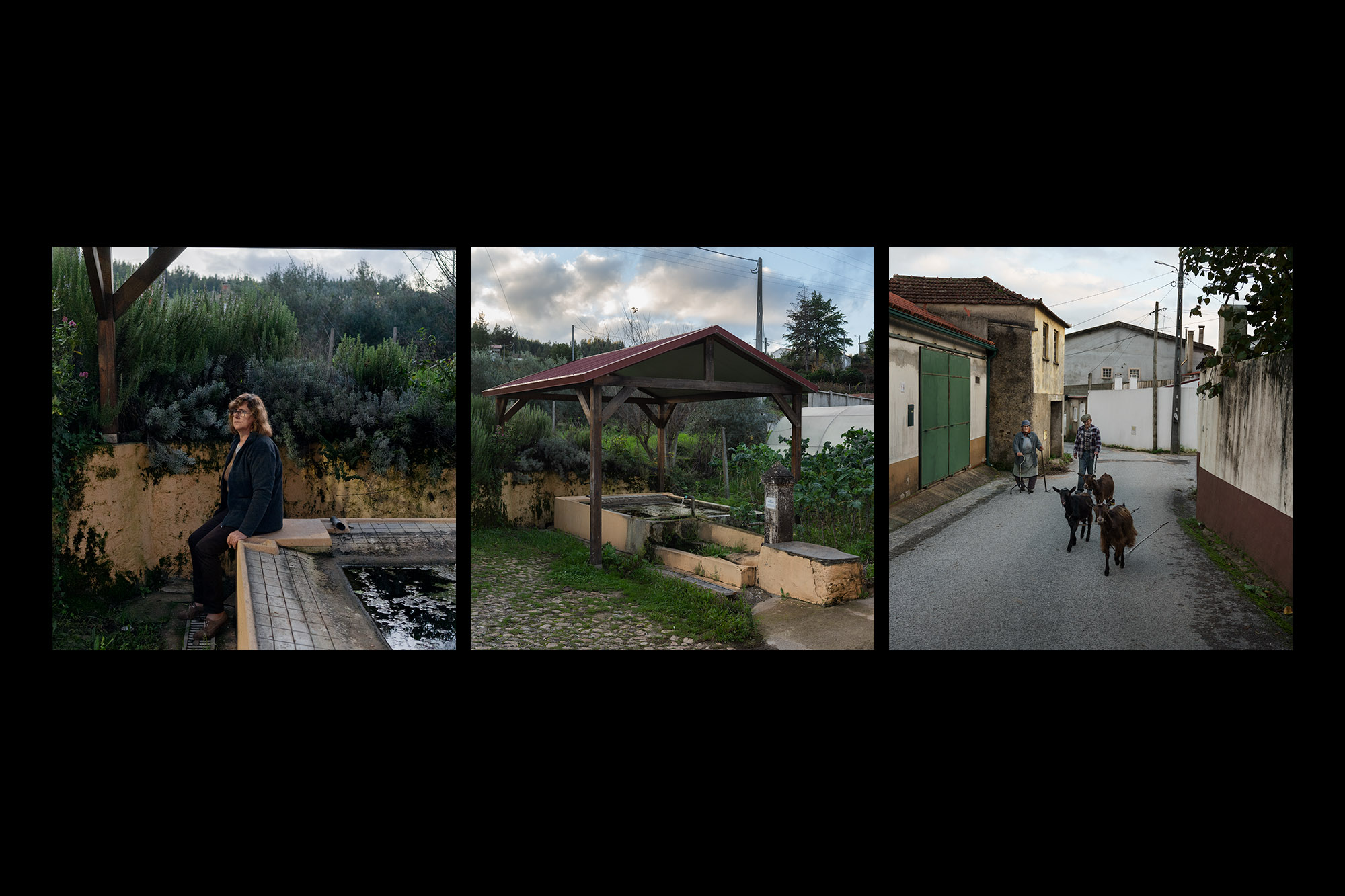
Maria do Céu Silva reflects on the night of the mega fire which killed 11 of her neighbors in the small town of Nodeirinho. Céu and a dozen others survived the fire by sheltering in the water tank beside her home. She says Nodeirinho hasn’t been able to return to the vibrant place it once was before the blaze. © Paulo Nunes dos Santos for Sonda Internacional
The fire and the evidence of its destruction across the town mean residents like Céu are trapped in a time capsule, unable to move forward. “I used to actually be a very fun person and I think that since that happened, I’m not. Because we leave the house, I speak for myself, and go to my work and pass by several places where victims died. It marks us every day no matter how much we go through and forget, we remember every day”.
Among the town’s victims were two children aged three and four, and several people in their 30s. Céu says much like in Sarzedas de São Pedro, they had filled the town with activity and dynamism. Now the chemistry of the tiny village has changed dramatically. Deathly quiet and still ash-stained, it feels ghostly with virtually no passing foot or car traffic. Céu says many of the remaining population are elderly and mostly stay inside their homes. In summer, when the wind picks up Céu fears fire will return to the town.
Gonçalo’s tomb in the Castanheira de Pêra cemetery, in the central region of Portugal. © Mikel Konate for Sonda Internacional
GONÇALO
Monuments dedicated to the victims of the Pedrógão Grande fire are scattered across the region. Written on all of them is the name of the only firefighter who died, Gonçalo Fernando Correia Conceição. The charismatic and well-loved firefighter was known as “Assa” or “Dr. Assa” (from the Portuguese ‘assar’, meaning ‘to grill’) due to his renowned barbequing skills and restaurant of the same name.
The 39-year-old is missed by many within the community he was so involved in, but none feel the loss more than his family. Six years on from the fire, his parents strain to speak through the grief. They, and Assa’s 17-year-old son David, live with the consequences of his selfless decision to routinely run into danger to help others, “It’s the life he chose, that’s it. It was his way to help others.” said his father, Joaquim Domingos da Conceição, 69.
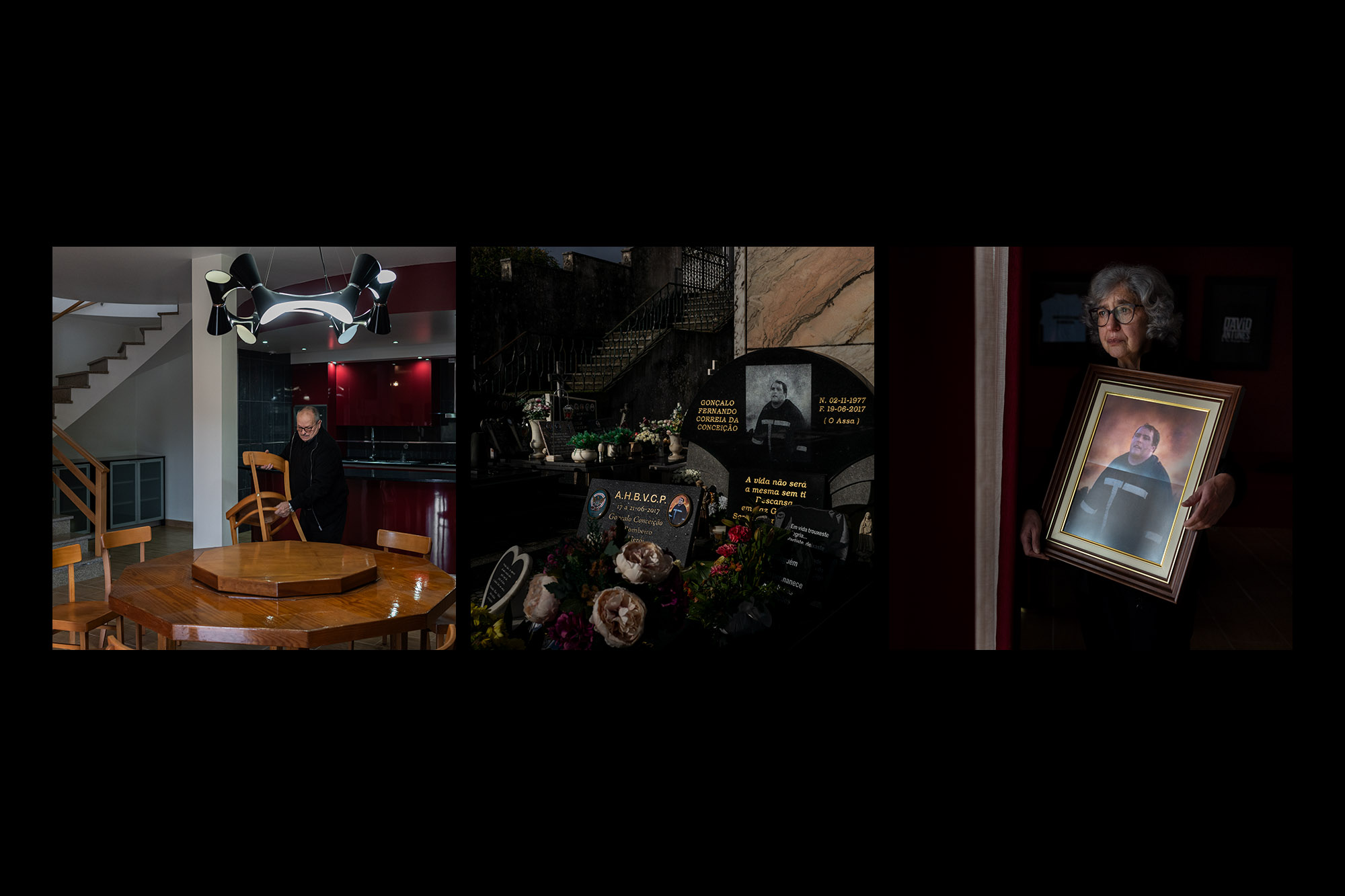
Castanheira de Pêra firefighter, Gonçalo Fernando Correia Conceição, died during the mega fire of 2017. His grief stricken parents have maintained his home in the hopes their grandson will one day live there. © Paulo Nunes dos Santos for Sonda Internacional
Hotelier Joaquim and his wife, Maria da Conceição, 63, have kept their son’s house in pristine condition in the hopes their grandson, who had to move away after Assa’s death, will someday return to the town and take over his father’s restaurant. Like many families, they experienced a double desolation when the death of a loved one prompted other family members to move away.
Inside Joaquim and Maria’s lakeside hotel in Castanheira de Pêra a huge quote has been painted on the wall of the dining hall, it reads, ‘May my presence never be forgotten in my absence! Thank you friends. - Dr. Assa.’ His parents say they have no fear their son will ever be forgotten.
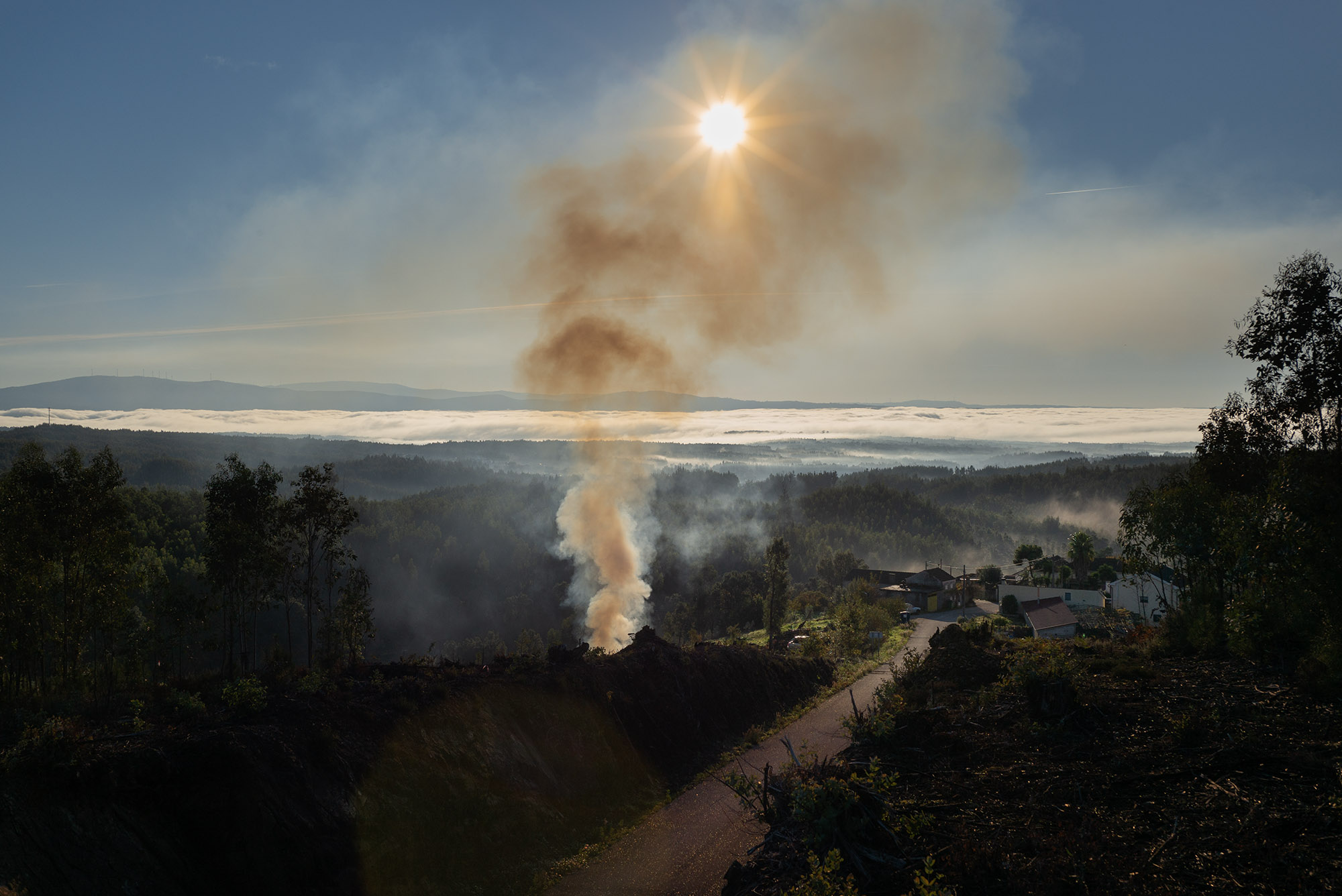
Smoke rises over the town of Pobrais from a controlled burn on a property in winter of 2023. © Paulo Nunes dos Santos for Sonda Internacional
The Pedrógão Grande mega fire
The Pedrógão Grande mega fire shaped a region by tragedy, causing profound human consequences that have left scores of people battling their own memories, questioning their safety and working through trauma. For those, the fire is unfathomable to forget. But in the wider community others are eager to leave it in the past and focus on the future.
While these communities oscillate between the two outlooks, the vegetation surrounding them has been quietly regrowing. Now the build-up has reached levels higher than before the fire and many fear history could repeat when the region almost inevitably faces future weather extremes.
Government forestry workers are attentively cutting back trees closeby to roads and houses while homeowners like Deolinda and Antonio race tirelessly against the growth of the pines closing in around them. Looking at the dense forests threaded throughout his town Joaquim Conceição says the work doesn't go far enough, “Another similar tragedy could happen tomorrow,” he said. Meanwhile, the graves of Ana Bernardo’s parents lay claustrophobically encircled by the same thick vegetation that accelerated the fire that caused their deaths.
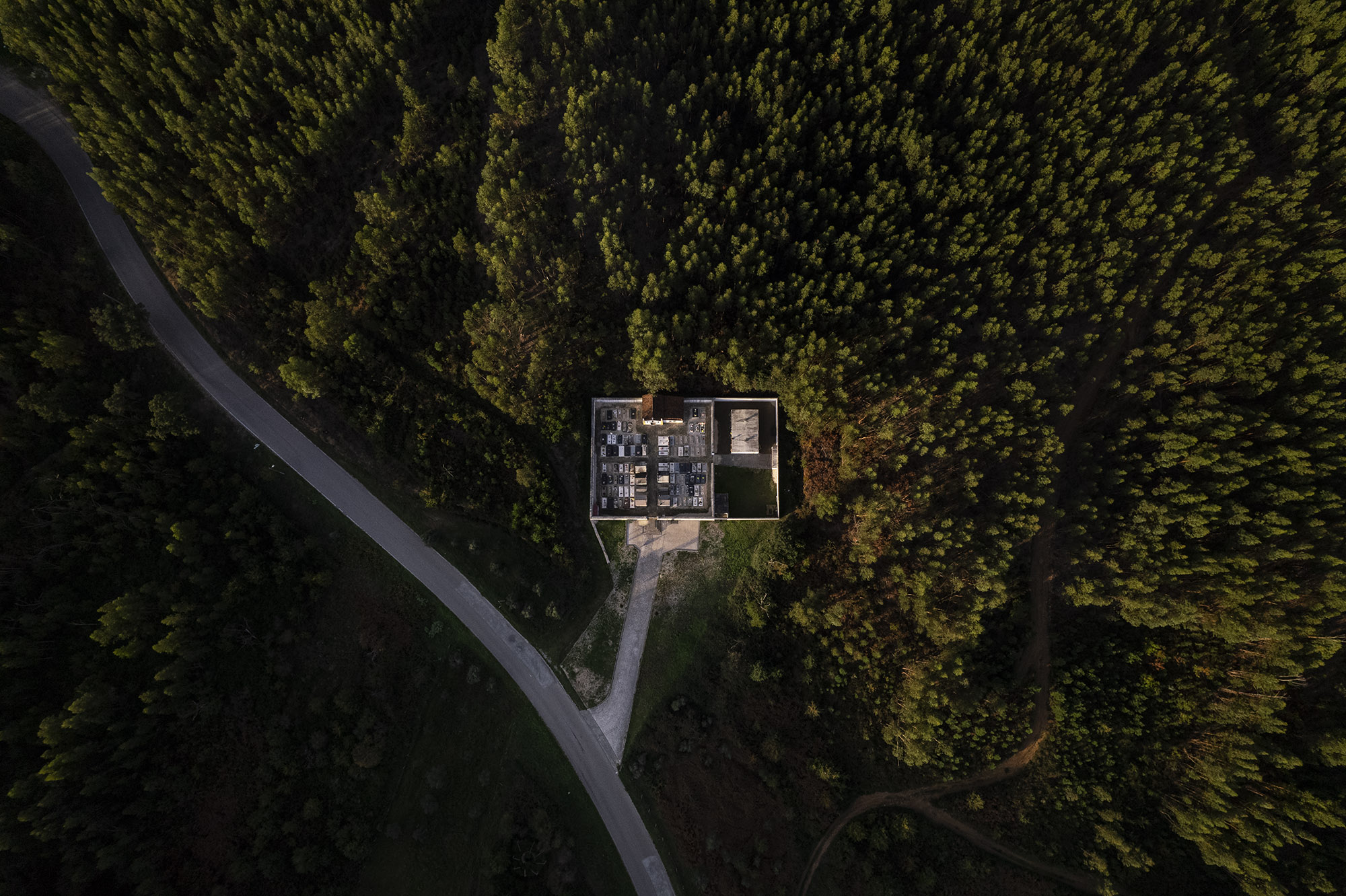
Sarzedas de São Pedro Cemetery, where several of the victims who died in the Pedrógão Grande fire are buried, is now surrounded by a eucalyptus forest. © Mikel Konate for Sonda Internacional
Credits
Director: Mikel Konate | Text: Lily Mayers | Photography: Paulo Nunes dos Santos, Mikel Konate | Video: Mikel Konate | Colourist: Joan Roig |Illustration: Jorge Mileto | Text editing: Maribel Izcue | Photo editing: Santi Palacios | Web development: Full Circle | Production: Sonda International

How did we execute this story?
To compile this report we spent a month embedded in the towns surrounding the municipality of Pedrógão Grande, Portugal in late 2023. To understand the scope of this story, we conducted hours of interviews with more than 20 subjects including survivors, witnesses, local residents as well as relevant fire and forest management experts. Following the investigation, another month of post production was done in Spain and Ireland.
Sonda Internacional would like to thank all who appear in this report for their generosity in sharing their experience and testimonies.
Mega Fires: Beyond Extinction
The Open Wounds of Pedrógão Grande report forms part of the larger Mega Fires: Beyond Extinction project, a major undertaking only possible thanks to the collaboration of experts and, above all, the community of members who support us in making visual journalism on the climate crisis.
You can see other chapters within the report and watch our Conversaciones series bringing together firefighting, forest engineers, and climate experts here.
The project is well underway, but we need more help to complete it. You can become a monthly or annual member (or make a one-time donation) here.


